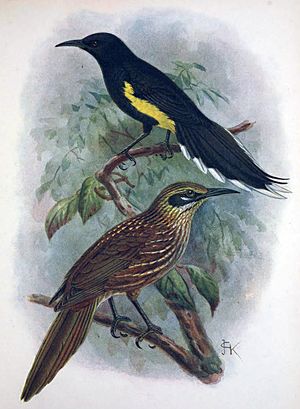Oʻahu ʻōʻō facts for kids
Quick facts for kids O‘ahu ‘ō‘ō |
|
|---|---|
 |
|
| Conservation status | |
| Scientific classification | |
| Genus: |
Moho
|
| Species: |
apicalis
|
The O‘ahu ‘ō‘ō (Moho apicalis) was a special bird that lived only on the island of O‘ahu in Hawai‘i. It belonged to a group of birds called ‘ō‘ōs, all of which are now extinct. Scientists used to think it was related to honeyeaters, but now they know it was part of its own unique family, the Mohoidae. Sadly, this beautiful bird disappeared a long time ago.
Contents
What the O‘ahu ‘ō‘ō Looked Like
Male O‘ahu ‘ō‘ōs grew to be about 30.5 centimeters (about 12 inches) long. Their wings were around 10.5 to 11.4 centimeters (4 to 4.5 inches) long. The females were a bit smaller than the males.
Most of their feathers were a sooty black color. Their tail feathers were brown, and many of them had white tips. Under their wings, they had cool white feather tufts. A special feature was their two middle tail feathers, which were very thin and looked almost like hair. The sides of their bodies and the feathers under their tails were a bright, deep yellow. Both their beaks and legs were black. We don't know much about their daily lives or habits.
Where the O‘ahu ‘ō‘ō Lived
This bird lived in the mountain forests of O‘ahu, one of the Hawaiian Islands. These forests were its only home.
Why the O‘ahu ‘ō‘ō Disappeared
The O‘ahu ‘ō‘ō was first seen and written about by a naturalist named Andrew Bloxam in 1825. He was on a ship called HMS Blonde and saw live birds that local people brought to him. He noted that the birds were already very rare and expensive to get.
Even though it was already gone, the O‘ahu ‘ō‘ō was officially named and described by a scientist named John Gould in 1860. The last time anyone reliably saw these birds was in 1837. A German naturalist, Ferdinand Deppe, collected about three of them in the hills near Honolulu.
Later, in the 1880s and 1890s, scientists like Robert C. L. Perkins searched for the bird but couldn't find any. This led them to believe it was almost extinct. Today, there are only seven specimens of the O‘ahu ‘ō‘ō left in museums around the world, including in Berlin, London, New York City, and Cambridge.
Several things likely caused the O‘ahu ‘ō‘ō to become extinct:
- Diseases: New diseases carried by introduced mosquitoes probably harmed the birds.
- Habitat Loss: Animals like cattle and goats, brought to the island by humans, destroyed the forests where the birds lived.
- Deforestation: People cut down many trees, which also destroyed the birds' homes.
- New Predators: Rats, which arrived on the island with ships, might have eaten the birds' eggs and chicks.
- Hunting: The birds' beautiful yellow feathers were sometimes used to make special robes for Hawaiian royalty.
See also
 In Spanish: Moho apicalis para niños
In Spanish: Moho apicalis para niños
Images for kids




